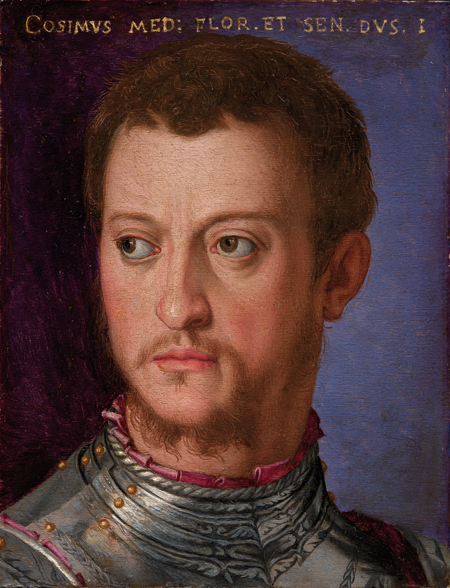
Continuing through September 15, 2013
A rare amalgam of treasures owned by the fabulously wealthy Medici banking/royalty/clerical family (15th to 18th century) is culled from several museums in Florence, Italy, brought together for the first time. The selection of about 100 pieces comprises Renaissance era gems in hard and semi-precious stones, gold and silver, along with ancient cameos, coins and jewelry. It also includes eight terracotta busts of successive Medici family members who accumulated these priceless pieces over the centuries. Florence, known throughout the Medici's heyday as the “city of art,” served as residence to the likes of Ghiberti, Donatello, Botticelli and most of all Leonardo da Vinci and Michelangelo, along with an endless parade of architects, goldsmiths, silversmiths and engravers.
Thanks to the show’s curators, the exhibition is also a history lesson about the Medici family’s enduring power, wealth and shrewd ability to acquire rare gems, told through didactics and a timeline. This compelling backstory tells of a family that dominated state affairs, consorted with royalty and Popes, and helped steer the course of European history and art. The Medici’s displayed and traded gems, including those from antiquity, to dazzle for diplomatic and political purposes, as well as to fund workshops for artists and artisans and commissioned artworks. The most influential family member was Lorenzo (The Magnificent) de’ Medici (1449-1492), a scholar, statesman and patron of the arts. This “benevolent dictator” founded the school for sculpture where Michelangelo apprenticed, expanded the family collections of manuscripts, cameos and gemstones and commissioned artisans to copy and alter ancient gems. Admired by Niccolò Machiavelli, Lorenzo served as the model for his infamous treatise, “The Prince.”
Various pieces in this exhibition reveal the Medici’s alteration and enhancement of ancient Roman and Greek originals. “Chariot with Male Figure,” originally a Hellenistic onyx fragment depicting the hind legs of two horses, was augmented with gold by 16th century craftsman Benvenuto Cellini; he added the missing horses' heads and the figure of Greek goddess Nike. The ancient Roman “Bacchus and Ariadne in Naxos” onyx cameo was enhanced with enameled gold mounting and pearl. Another ancient piece, “Female Bust (Drusilla)” in onyx and gold had a halo cut into the stone 1500 years later to transform Drusilla, sister of Caligula, into a Christian saint.
Several of the pieces from antiquity remain intact. These include the sardonic cameos “Icarus and Dedalus, Pasiphae and Artemis” and “Dyonisus on a Chariot Drawn by Psychai.” The latter, originally belonging to Pope Paolo II Barbo, was acquired by Lorenzo. Also on view is the second largest known cameo in the world, “Emperor Sacrificing to Hope” (2nd to 4th century CE) at 14.2 mm in diameter, crafted of rich brown and white onyx with gilded metal. A similar 16th century cameo, crafted with techniques borrowed from ancient times, is “Busts of Cosimo I de’ Medici and Eleonora of Toledo,” of agate and gold. One of the few paintings in this show is “Portrait of Cosimo I,” a life-like oil on tin of the first Grand Duke, painted during his lifetime (1519-1574).
The most graphic work in this exhibition is a life-size photograph of “The Studiolo of Francesca I” (1540) in the Palazzo Vecchio, a room commissioned by Cosimo I. This 30 x 10 foot space features paintings on floor to ceiling doors and cabinets, each painting alluding to the numerous precious gems within the cabinets; the room was built to house gems to be shown to select royalty, dignitaries, politicians and the clergy. Another elaborate work is the two and a half foot square “Hinged Panel of the Cabinet of Francesco I de Medici” (1587), used to store medals, cameos and intaglios. This magnificent ebony cabinet cover is adorned by 60 symmetrically arranged hard stones in a profusion of colors. A later piece is the 17th century “Table Top with Parrot,” a multi-colored marble mosaic, inlaid with hard stones.
Two hundred years later, following the death of the last Grand Duke Gian Gastone (1671-1737) and the decline of the family, the fame of the Medici collection spread throughout Europe and soon became available for viewing by select audiences. An accompanying video explains that while the Medici family was often calculating and ruthless, they were also magnanimous, attracting and supporting artists and great artwork, playing a dramatic role in shaping the Renaissance. The astute visitor might leave the exhibition pondering the role of the arts today, while wondering whether this era’s financial titans might similarly spawn a new, and hopefully less self-serving renaissance.
Published courtesy of ArtSceneCal ©2013
